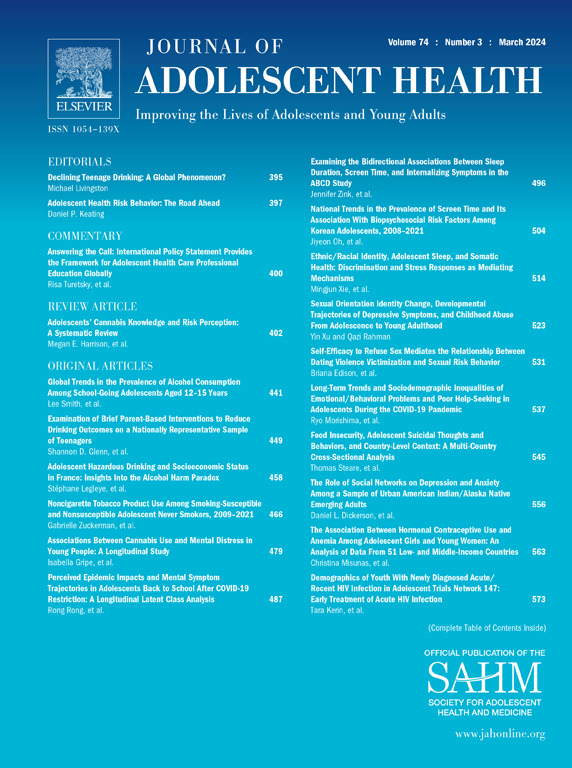南加州一个大型综合医疗保健系统在 COVID-19 大流行期间的青少年抑郁症筛查结果趋势。
IF 5.5
2区 医学
Q1 PEDIATRICS
引用次数: 0
摘要
目的:在 COVID-19 大流行期间,人们对青少年初级医疗保健中抑郁症筛查结果的变化知之甚少。我们描述了南加州一个大型综合医疗保健系统中抑郁症筛查结果的变化趋势:我们以 6 个月为单位,提取了 2017 年 3 月 1 日至 2022 年 8 月 31 日期间对 11-12 岁和 13-17 岁青少年进行抑郁症筛查的预防性医疗就诊的回顾性电子健康记录数据。符合 "抑郁阈值 "的筛查百分比按性别、种族或民族以及家庭收入中位数五等分进行了总体报告。我们使用泊松回归法估算了 3 个冬季区块(9 月至次年 2 月)中阈值抑郁的比率,并对封锁期(2020 年)、重新开放期(2021 年)与 COVID 前(2019 年)以及重新开放期相对于封锁期进行了比较。使用交互项检验了性别、种族或民族以及家庭收入的趋势差异:在735,333人次的完整筛查中(11-12岁儿童为183,550人次,13-17岁儿童为551,783人次),11-12岁儿童中分别有4.6%、6.5%和7.4%的人在COVID前、封锁和重新开放的冬季区块中患有 "阈值抑郁症"。13-17 岁儿童的相应比例分别为 5.8%、8.5%和 9.8%。对于两个年龄组的青少年来说,封锁和重新开放期间的 "抑郁 "率均高于 COVID 前,而重新开放期间的 "抑郁 "率则高于封锁期间(所有 p 值均为讨论值):自 2020 年 3 月 COVID 关闭以来,加州青少年的抑郁阈值有所上升,2021 年 9 月重新开放期间观察到抑郁阈值进一步上升。需要进行未来研究以确定长期趋势。本文章由计算机程序翻译,如有差异,请以英文原文为准。
Trends in Adolescent Depression Screening Outcomes Over the COVID-19 Pandemic at a Large, Integrated Health Care System in Southern California
Purpose
Little is known about changes in depression screening outcomes among adolescents in primary healthcare across the COVID-19 pandemic. We describe trends in depression screening outcomes within a large integrated health care system in Southern California.
Methods
Retrospective electronic health record data from preventative healthcare visits of 11–12-year-olds and 13–17-year-olds screened for depression from March 1, 2017, to August 31, 2022, were extracted in 6-month blocks. The percentages of screens meeting “threshold depression” were reported overall, and by sex, race or ethnicity, and median household income quintiles. We used Poisson regression to estimate rate ratios of threshold depression in 3 winter blocks (September to February) comparing lockdown (2020), reopening (2021) to a pre-COVID (2019) period, and reopening relative to lockdown. Disparities in trends by sex, race, or ethnicity and household income were tested using interaction terms.
Results
Of 735,333 visits with complete screening (183,550 for 11–12-year-olds and 551,783 for 13–17-year-olds), 4.6%, 6.5%, and 7.4% of 11–12-year-olds had “threshold depression” during winter blocks of pre-COVID, lockdown and reopening, respectively. The corresponding rates were 5.8%, 8.5%, and 9.8% for 13–17-year-olds. The rates were higher during lockdown and reopening relative to pre-COVID and higher during reopening relative to lockdown for both age groups (all p-values <.001). Trends differed by sex in both age groups (p-values <.001) and by race or ethnicity (p = .001) in the 13–17-year age group.
Discussion
Californian adolescents demonstrated an increase in threshold depression since COVID lockdown starting March 2020 with further increase observed during reopening in September 2021. Future studies are needed to determine the long-term trends.
求助全文
通过发布文献求助,成功后即可免费获取论文全文。
去求助
来源期刊

Journal of Adolescent Health
医学-公共卫生、环境卫生与职业卫生
CiteScore
10.40
自引率
3.90%
发文量
526
审稿时长
46 days
期刊介绍:
The Journal of Adolescent Health is a scientific publication dedicated to enhancing the health and well-being of adolescents and young adults. Our Journal covers a broad range of research topics, spanning from the basic biological and behavioral sciences to public health and policy. We welcome a variety of contributions, including original research papers, concise reports, literature reviews, clinical case reports, opinion pieces, and letters to the editor. We encourage professionals from diverse disciplines such as Anthropology, Education, Ethics, Global Health, Health Services Research, Law, Medicine, Mental and Behavioral Health, Nursing, Nutrition, Psychology, Public Health and Policy, Social Work, Sociology, and Youth Development to share their expertise and contribute to our mission of promoting adolescent health. Moreover, we value the voices of young individuals, family and community members, and healthcare professionals, and encourage them to submit poetry, personal narratives, images, and other creative works that provide unique insights into the experiences of adolescents and young adults. By combining scientific peer-reviewed research with creative expressions, our Journal aims to create a comprehensive understanding of the challenges and opportunities in adolescent and young adult health.
 求助内容:
求助内容: 应助结果提醒方式:
应助结果提醒方式:


